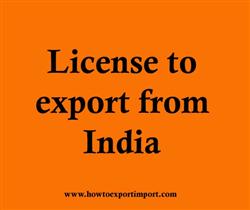Export License
As per the Foreign Trade Policy, all goods may be exported without any restriction except to the extent such exports are regulated by the ITC (HS) classification of Exports and Imports items or any other provision of the Policy, or any other law for time being in force. The restricted items can be permitted for export under licence.
 An export license is a document issued by the appropriate licensing agency after which an exporter is allowed to export under the restricted category of the ITC (HS) classification of Exports and Imports. The license is issued only after a careful review of the facts related to the given export transaction. Export license depends on the nature of goods to be transported as well as the destination port, So, being an exporter it is necessary to determine whether the product or goods to be exported requires an export license or not.
An export license is a document issued by the appropriate licensing agency after which an exporter is allowed to export under the restricted category of the ITC (HS) classification of Exports and Imports. The license is issued only after a careful review of the facts related to the given export transaction. Export license depends on the nature of goods to be transported as well as the destination port, So, being an exporter it is necessary to determine whether the product or goods to be exported requires an export license or not.
To determine whether a license is needed to export a particular commercial product or service, an exporter must first classify the item by identifying what is I called ITC (HS) Classifications. Export licenses are only issued for the goods I mentioned in the Schedule 2 of ITC (HS) Classifications of Export and Import items. A proper application can be submitted to the Director General of Foreign I Trade (DGFT). The Export Licensing Committee under the Chairmanship of Export Commissioner considers such applications on merits for issue of export licenses.
The Director General of Foreign Trade (DGFT) from time to time specifies through a public notice such terms and conditions according to which any goods, not included in the ITC (HS) classifications, may be exported without a license. Such terms and conditions may include Minimum Export Price (MEP), registration with specified authorities, quantitative ceilings and compliance with other laws, rules, regulations.
Barring a few items, which are totally prohibited for exports as discussed earlier, other items in the restricted list can be exported under a license or through designated agency under specified conditions. In addition to an export licence, certain procedures and conditions as specified in column 4 of Schedule 2 of the tic (HS) Classification of Export Import Items may be required to be complied with.
Some examples of the Items subject to export license and conditions are:
(a) Dress materials/ready-made garments fabrics/textile items with imprints of excerpts or verses of the Holy Duran.
(b) Live Horses - Kathiawari, Marwari and Manipuri breeds.
(c) Live Cattle, buffaloes and camel.
(d) Fresh or chilled or Frozen silver pomfrets of weight less than 300 gms.
(e) Wheat seeds (wild variety), paddy seeds (wild variety), cashew seeds and plants.
(f) Onion seeds, Saffron seeds or corms and Neem seeds.
(g) Fodder, including wheat and rice straw.
(h) Rice bran, raw and boiled.
(i) Sand and Soil.
(j) Urea.
(k) Pure races of Silk worms; silkworm seeds, and silk worm cocoons.
(l) Deoiled groundnut cakes containing more than 1% oil and groundnut expeller cakes.
(m) Vintage motor cars, parts and components thereof manufactured prior to 1.1.1950.
(n) Vintage Motorcycles, parts and components thereof manufactured prior to 1.1.1940.
When can an exporter release bill of lading from shipping company?
When does exporter get EP copy of shipping bill after customs clearance
How does CFR term of delivery work in Export Import business
How does comprehensive policy of ECGC work for exporters?
The role of CBEC - Central Board of Excise and Customs in India.
The role of Export Inspection Agency in Pre-shipment Inspection & Quality Control
The role of Reserve Bank of India
The Role of the International Chamber of Commerce (ICC)
Negotiation procedures and formalities of export bills
Non receipt of Cargo Arrival Notice, Can importer sue against shipping company
OBJECTIVES OF CUSTOMS CONTROL for EXPORT GOODS
OBL not released OBL not surrendered no telex release
Payment procedures in Triangular exports
Who is Stevedores
Who receives the amount of auctioned / resold imported unclaimed/un-cleared goods?
Why demurrage/detention waiver period is required at destination for import
Why do carriers balance weight and volume while charging freight amount in Exports?
Why does Palletization require?
Why labeling and marking in Export business?
The term FCL. What is FCL means
The term LCL. What does LCL mean?
Tips to exporters on Documentation
How does First Appraisement system of import customs clearance procedures work?
How does Letter of Credit work?
How does STP units work in India?
How does TT (Telegraphic Transfer) work?
Transferability of Bill of Lading
Transhipment - A redefinition
Travelers to India under import duty exemption, Frequently Asked Questions Part 2
Triangular shipment
Types of Insurance Documents.
How does Wire transfer work in international business?